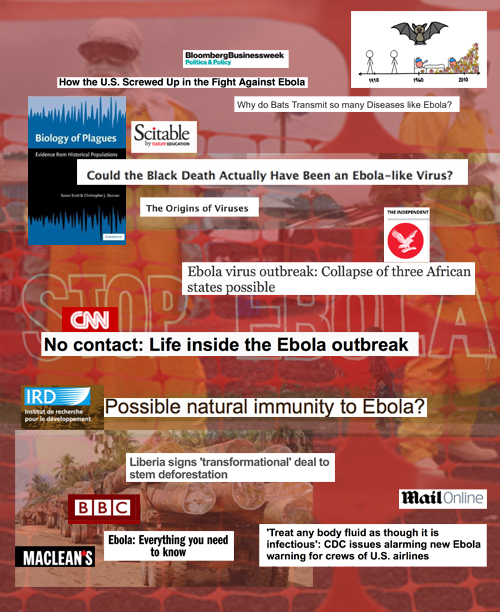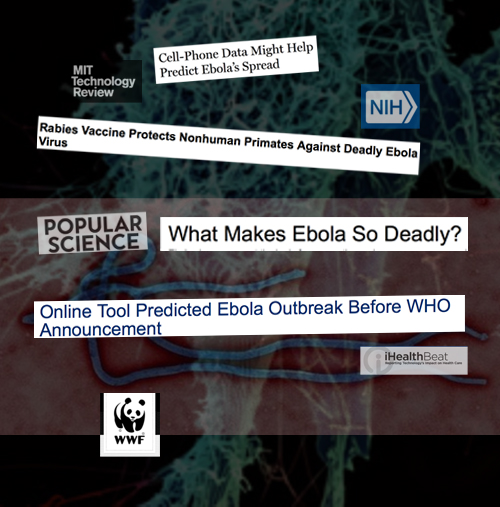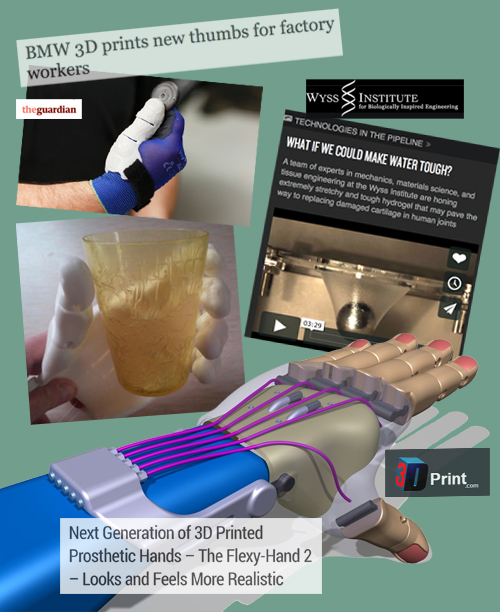| On pleas, politics, pathology, wonder drugs, deforestation, evolution, Black Death, Russian Anti Plague program, butterfly effect, amazing bat biology, repeating mistakes and why environmental scientists should be put in charge of public health and we all need to follow Norway’s lead Ebola poses no significant risk to the United States. Only one of those two statements is correct and it is not the one by the government agency charged with protecting the public’s health. While it is true that the health infrastructure in the US makes it unlikely that an Ebola epidemic could catch hold here, even a small cluster of cases could be enough to spark panic. A few weeks ago, when two American patients under tight biosecurity were flown back to the US from West Africa for treatment, there were complaints (see Donald Trump). Ebola may not easily be turned into a bioweapon, but it is still on the CDC’s list of such potential threats. It is that kind of scary. For now, direct costs to the US are limited to troops and supplies being sent to three countries—Guinea, Sierra Leone and Liberia—reeling from the outbreak. Stories of unimaginable horror are matched only by dire predictions that the number of cases could spike to as high as 1.4 million by January. American efforts alone won’t be enough to turn things around, and even those are being hampered by, of all things, the weather. It is the rainy season, which means that some roads—including five leading to sites where the US plans to set up treatment centers—are currently impassable. Ebola’s collateral damage is as insidious as it is extensive. Were the virus to be stopped in its tracks immediately, it would still rank as the largest outbreak by far since Ebola was first identified nearly 40 years ago. The death count has now passed 3,000, which is roughly twice the combined tally of all 25 previous outbreaks. Deaths are just the tip of the iceberg. With schools closed, layoffs rampant, crops left unharvested and a health system so shredded that people are dying of otherwise treatable diseases such as malaria, Ebola has blighted families and futures for years to come. That is the best case scenario. The worst case—1.4 million victims by January—is just too terrible to imagine. Even 10% of the worst case would leave a generation of orphans in its wake because women, as primary caregivers, have been particularly hard hit. "I tell them to put their faith in God, and that all is not lost," said Famata Dunoh, who runs the Unicef-supported centre with the help of four other women. “And I tell them: ‘only God knows the reason why you survived Ebola and your parents did not’… THE BUTTERFLY EFFECT GONE VIRAL The ramifications, President Obama points out, are global. A tiny virus with just a handful of genes can kill a person, fracture families, shred communities, destroy economies, undermine political status quos, topple countries and destabilize whole regions with ever-escalating consequences, all in a matter of months. To keep the lid on Pandora’s microbial box, funds that until recently have been tied up in bureaucratic bows have been quickly untied to fast-track research and the manufacture of vaccines, antiviral drugs and novel therapies such as ZMapp, an “antibody cocktail.” Ebola, it turns out, does not kill directly, but rather co-opts its victims’ defenses so they effectively kill themselves. The virus stealthily evades the immune system while it spreads through the body (a process that can take weeks). By the time the immune system kicks into gear, the response is both too late and too much: a “cytokine storm" destroys everything in its path. Those few that manage to survive the onslaught at least have immunity against a repeat attack (at least by the same viral strain), so theoretically a vaccine should work. The challenges are both scientific and logistic. Even if there were an effective vaccine existed stockpiled in adequate quantity, distribution presents yet another hurdle, especially if the vaccine needs to be kept at a specific temperature. The efforts to use cutting edge research and technology to outmaneuver an enemy with such a substantial head start and a home court advantage have been impressive, but a lot of things will need to start going right fast in order to make a difference. The tragedy of the tragedy is that there were plenty of early warning signs. Yet just as the virus manages to escape detection in the early days of an infection, these kinds of warnings seem beyond the ken of most public health departments. HIDING IN PLAIN SIGHT Imagine an aerial time-lapse video of the last decade in West Africa and the first clue pops out right away: deforestation on a truly epic scale. Guinea’s rainforests have been reduced by over 80%, while Liberia has sold logging rights to over half its forests since 2005. Sierra Leone, with a meager 4% of its forests left, is on track to be completely deforested within a few years. This is key because fruit bats, Ebola’s reservoir host (they carry the virus but generally don’t die from it), live in forests. Their home is literally being cut down around them, forcing them to look for alternatives. Meanwhile, mining has become big business, employing thousands of workers who travel into the forest to get to the mines. Bottom line: bats and people increasingly coming into contact. Bats, along other animals susceptible to Ebola, have long been on the menu in West Africa, but there are other transmission routes besides bushmeat. Nipah, a related virus also carried by bats, first appeared in Malaysian pigs who fell ill eating fruit that had fallen into their pens after first being nibbled by bats. The fruit was contaminated by virus in the bats’ saliva. It is entirely possible, then, that the two year-old boy identified as the first human victim in the West African outbreak picked up Ebola in a similar manner: eating bat-contaminated fruit. There are huge colonies of bats which regularly migrate. They can travel far in one night. I don’t think an individual bat or colony migrated all the way fromCongo or Gabon to west Africa. These big colonies are connected. There is a possibility for the virus to mix between colonies. They [the bats] share the same fruit. It is likely not to have even been one species of bat. The virus may jump from one species to another.” This is the same way West Nile virus managed to spread across North America in a matter of just a few years (though with an insect vector added to the mix). Migrating birds infected by mosquitoes became reservoir hosts. Mosquitoes could now both pick up virus from birds as well as spread it to other birds. Direct bird to bird transmission also played a role. Mingling among flocks en route between North and South America during spring and fall migrations spread it between species, who then flew it home to their respective nesting grounds. AN OLD STORY Officially identified in 1976 after an outbreak in Zaire and named after a nearby river, Ebola has actually been around for millions of years. In fact, researchers have evidence that filoviruses, the family to which Ebola belongs, may go back as far as 10 million years. The virus’ relationship with bats is a tale of nested evolution. Bats live in dense colonies where illness can quickly spread. Ebola may initially have caused a great deal of bat mortality, but the genes of the fittest—those for whom the virus wasn’t as serious—eventually prevailed. Bats also have an extraordinary ability to repair damaged DNA, which evolved as a result of flight. It takes so much energy to fly that a bat’s temperature increases several degrees in the process, which can wreak havoc on genetic material. In effect, bats have a fever every time they fly. This means that only viruses that are also able withstand the heat survive. The result: a migrating mammalian reservoir of germs for which the human body is ill-prepared. Nevertheless, some humans have developed a natural immunity to Ebola without getting sick. In 2010, the French Institute for Research and Development (IRD) reported the results of a three-year study in Gabon testing over 4,000 blood samples for Ebola antibodies: “…The prevalence rate varied significantly between regions, but the averagefound was 15.3%, the highest value so far reported for this disease. The savannah areas and the plains revealed intermediate rates of 10.5 and 12.4% respectively. In the Lakeland areas, only 2.7% of inhabitants possessed antibodies, whereas in the forest zones the rate reached 19.4%, even as high as 33.8% in some villages…” These people were infected by the virus, but never showed clinical symptoms. The rates were highest in forest zones likely because that is where the bats live. “…Great numbers of bats perch in the trees, eat fruit, particularly in sectors near the villages. The local people could therefore come into contact with the virus when they gather and eat fruit contaminated by these animals’ saliva….” This helps explain why previous outbreaks in rural areas were limited to a few dozen, though sometimes a few hundred, fatalities. The epidemic in West Africa, however, is a whole new ballgame involving a large, dense urban population with no native immunity. To the list of extremely bad news, add one more: the virus is rapidly mutating with potential implications for the development of vaccines and treatments. THE BLACK DEATH REVISITED? In 2001, two researchers from the University of Liverpool—Dr. Susan Scott, a demographer, and Dr. Christopher J. Duncan, a zoologist—published a book calledThe Biology of Plagues in which they argued that the Black Death, which was responsible for killing tens of millions of people in Europe in the mid-14th century, was not caused by bubonic plague as generally thought, but instead by an Ebola-like filovirus. (Their research is also available as a paper published by the Postgraduate Medical Journal in 2004: What Caused Black Death?) While the story seems to surface every few years in the press, the theory remains on the scientific fringes with serious questions raised about the rigor of the research. Still, given recent events, Scott and Duncan’s ideas are interesting. Among the evidence:
It wasn’t until 2005 that scientists became reasonably certain that bats were, in fact, the reservoir hosts of Ebola. In 2011, researchers discovered a related filovirus in European bats (though one that seems to pose more of a threat to bats than people). Perhaps there were overlapping epidemics with both scourges striking at the same time. It is deeply disturbing to consider that what we are seeing unfold in West Africa could possibly have happened before. MORE HISTORY AND LESSONS WORTH LEARNING Bubonic plague is a frightening disease in its own right, which is why Russian Tsar Nicholas II funded an Anti Plague program in Siberia during the construction of the Trans Siberian railroad in the 1890s. Plague was—and is—endemic in Siberia and Central Asia, carried by wild rodents who serve as reservoir hosts. Rats are like people in this particular disease equation: victims that die from the illness. Rats infested with plague-infected fleas could easily scurry aboard a Moscow-bound train (fleas are the vector that transmits the virus, just as water is the vector that transmits cholera). Even if the rats themselves died along the way, there were plenty of people onto which their disease-filled fleas could jump. Trains, then, could spread plague all along the route, though the threat to Moscow was especially worrisome. The Russians understood that trains tore across ecosystem boundaries in ways that the world had never experienced before, presenting new challenges to public health. The bubonic plague bacillus, Yersinia pestis, was identified in 1894, so the lab science was still in its early days. To unravel the mysteries of the plague’s transmission cycle, researchers had to go out into the field to observe wild rodents and their wild fleas. It took years of meticulous work, noting every detail about habitat and changes in the weather, but the Russians learned to identify the early warning signs that allowed them to effective preemptive action, stopping a human outbreak before it started. (During the Soviet era, the Anti Plague labs were folded into the nation’s budding bioweapons program, completely subverting the goal of public health into a tool for mass death.) We need to take a page from those pioneering Russians. The threat to public health from environmental degradation has never been greater. There are many more and much faster modes of transportation now and that is just a part of the picture. Massive deforestation has laid waste to vast, complex ecosystems, while carbon pollution has led to an increase in extreme weather and extended the range of disease-carrying bugs. There are also far more humans to be at risk: the global population has multiplied fourfold since the early days of the Trans Siberian. In a very deep and fundamental way, environmental health is public health. Yet conservation biologists typically are called upon only after there has been a new and scary disease outbreak, tasked with fingering which wild animals are to blame when the truth is we need only look in a mirror. These diseases are not “emerging,” to use the medical jargon. They are being unleashed—aided and abetted by bureaucracies designed to favor narrow specialization over broad (eco)systems thinking. When science and policy are out of sync, the only winners are pathogens. We need environmental scientists to connect the dots, provide perspective and take more central and powerful roles within public health. It may be a bit of a cliché to say it is all of a piece, but it really is. BETTER LATE THAN NEVER: THE LONG ROAD BACK TO EDEN Nature is an avid multi-tasker, which is why a deal to save Liberia’s remaining forests is such good news. Announced last week at the UN Climate summit,Norway has committed to paying Liberia $150 million dollars to stop deforestation by 2020. Norway’s support means the cash-strapped, Ebola-beleaguered country will not have to sell off what remains of its natural treasure to loggers. It also means its forests will continue to soak up atmospheric carbon for all of us, while preserving biodiversity, protecting watersheds, limiting erosion and serving as a natural disease barrier. That last benefit may not mean much in terms of Ebola, at least for now, but it may make a difference for another illness endemic to the region: malaria. A new study, one of a series of focused on the Brazilian Amazon, confirms a link between deforestation and increased rates of the disease in nearby communities. Why? Deforested land provides prime breeding conditions for mosquitoes. Nature, it has been said, bats last. We can no longer affect ignorance that what we have done to the planet won’t come back to bite us. We know better and the quality of our collective future depends on what we do next. For now, all we can do is hope that the global efforts to quash Ebola in West Africa are successful over the coming months, both for the people whose lives, families and countries hang in the balance and for the rest us for whom this is the most sobering of teachable moments. — J. A. Ginsburg RELATED • Global reforestation news and resources, Mongabay.com |
|
0 Comments
|
BackgroundDot to Dot grew out of the TrackerNews Project, a demo news aggregator developed for InSTEDD, an independent spin-off of Google.org's humanitarian practice that focused on health issues, humanitarian response and technology. Archives
• Bats, Trees And Bureaucrats: Ebola And How Everything, Positively Everything, Connects • Scrubba Dub Carlos and the Big Bad Enterovirus: Why Sneeze When You Can Sing? • Ebola, Bats and Déjà Vu All Over Again • Scaling Good: Project Frog’s Buildings And The Kitchen Community’s Learning Gardens • Thumbs Up And High Fives: Evolution, Hands And 3D Printing • Legos, Makers, Molecules, Materials And The Very Big Business Of Small Things • Solid: When Bits and Atoms Dance • Science Hack Day Chicago 2014: Reinventing The Space Suit, Cosmic Biomicmicry And The Joy Of Thinking Different • The Motors of August Cicadas • Mulling Snow, Climate, Pain Points, Bootstrapping And Chicago’s Advantage • Glass, Tech And Civilization: The Material That Makes Just About Everything Better • A Tale Of Two Maps And Why You Can’t Teach An Old Grid New Tricks • When Bad Things Happen To Good Content: Form(At), Function, Perspective And Possibilities • The Sum Of Its Parts: Autozone Meet Autodesk (Please) / On Supply Chains, Carbon Footprints And How 3D Printing Can Change The Game (Again) • It Takes An Economist: Tallying Natural Capital • Beyond Measure: Da Vinci’s Genius, Peripheral Vision, The Prepared Mind, Metric Traps And Hacking The Filter Bubble A Solstice Encore: Imaginary Carl Sagan, A Holiday Mix Tape And The Tannahill Weavers Categories
All
|







 RSS Feed
RSS Feed







